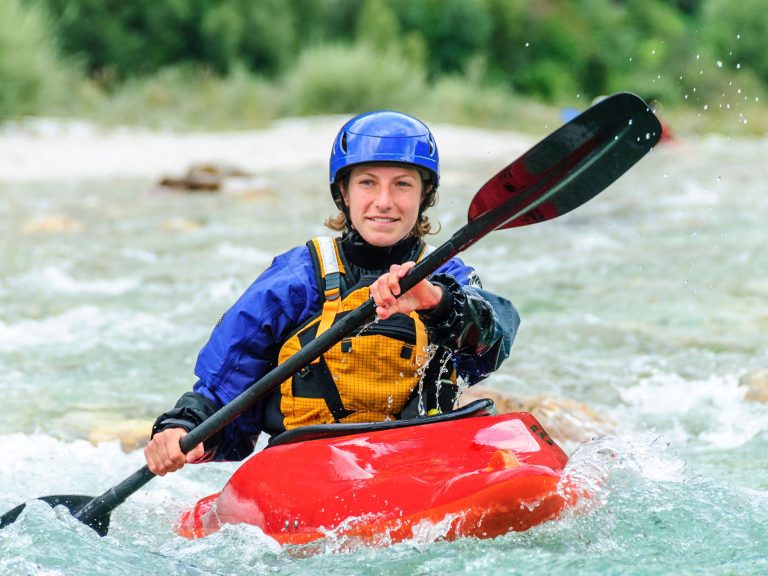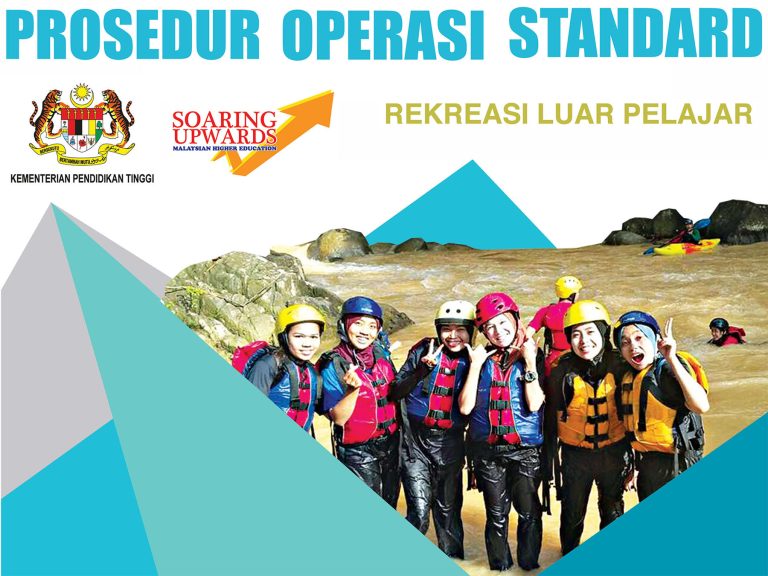A changing climate increases risks to outdoor programs—in ways both subtle and severe
The outdoor education center had students in the field—backpacking, rock climbing, and canoeing in wilderness areas across the American west. When lightning struck a few miles from the organization’s 335-acre high-desert headquarters campus, nestled at the base of a mountain range in southern California, at first, nobody noticed.
But the lightning ignited tinder-dry grasses, and driven by high winds and heat, a forty-foot wall of flame erupted, roaring towards the outdoor education center. The heat from the blaze ignited Joshua trees from 30 meters away, turning them into exploding infernos before the wall of flame even reached the plants.
Firefighters dropped fire retardant on the wildfire, but without effect.
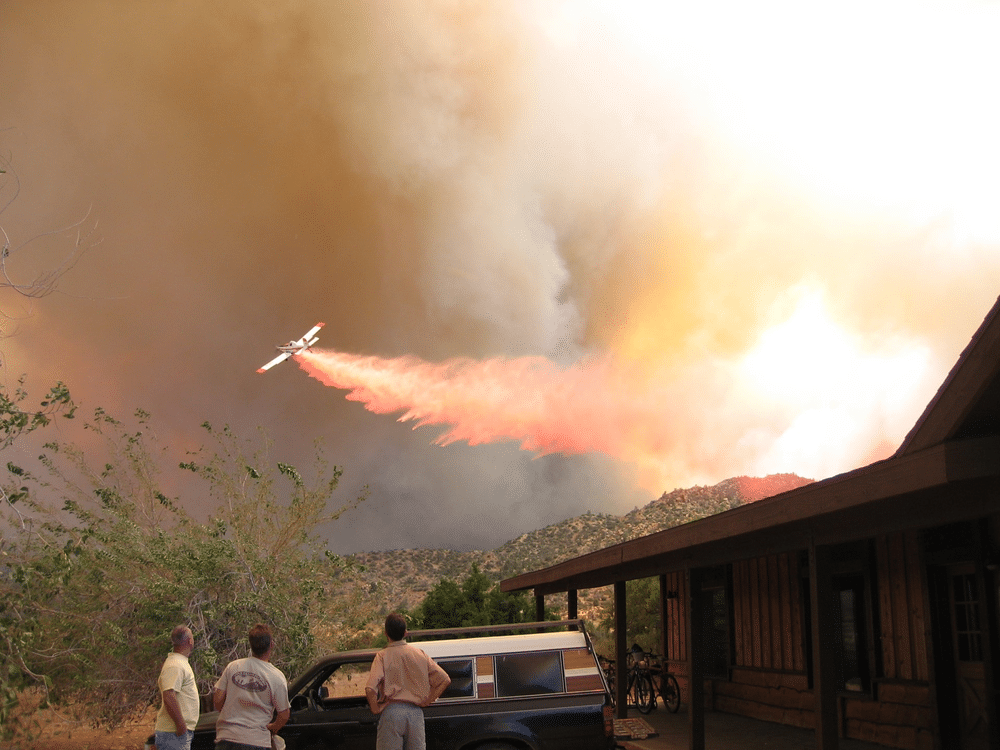
An airplane drops fire retardant over the outdoor education center campus.
Staff had 45 minutes to evacuate. As they drove away, flames were visible racing down a hillside towards the nonprofit’s campus.
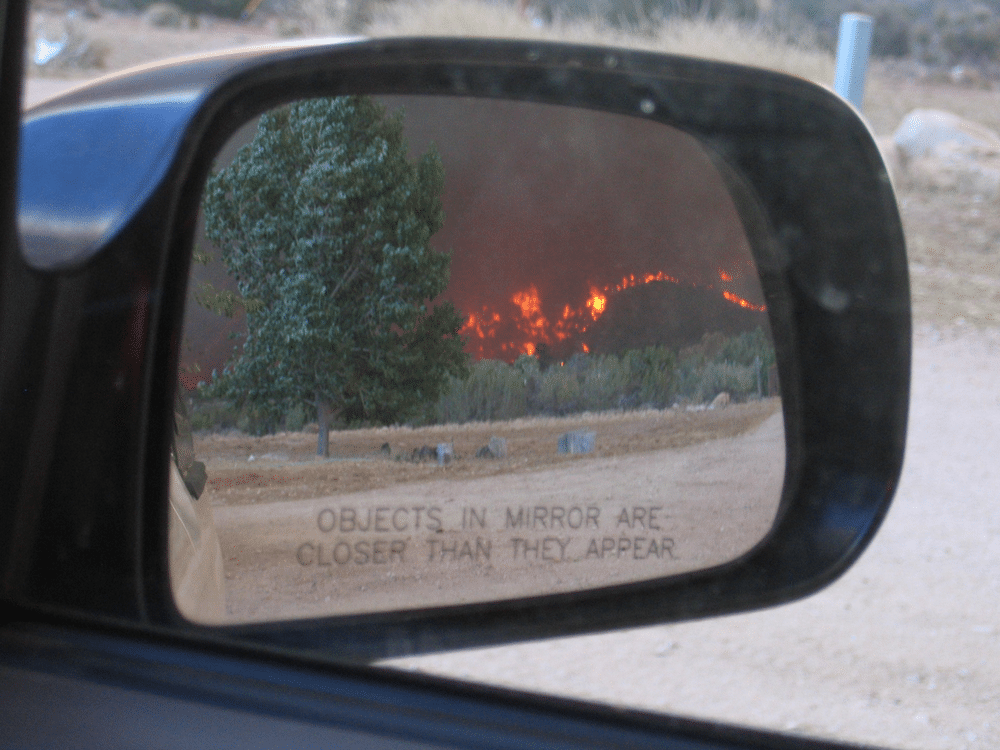
The wildfire was visible as outdoor program managers evacuated the center.
Fire truck after fire truck arrived. But the inferno overwhelmed the firefighters, who were forced to shelter in place in their vehicles, while the fire raged around them.
When the smoke cleared, the damage became clear. The organization’s offices, with 35 years of paper records, had been reduced to an 18-inch pile of ash. Blackened file cabinets stood like monuments among the cinders. The staff house, holding the personal possessions of 19 field instructors, burned completely to the ground.
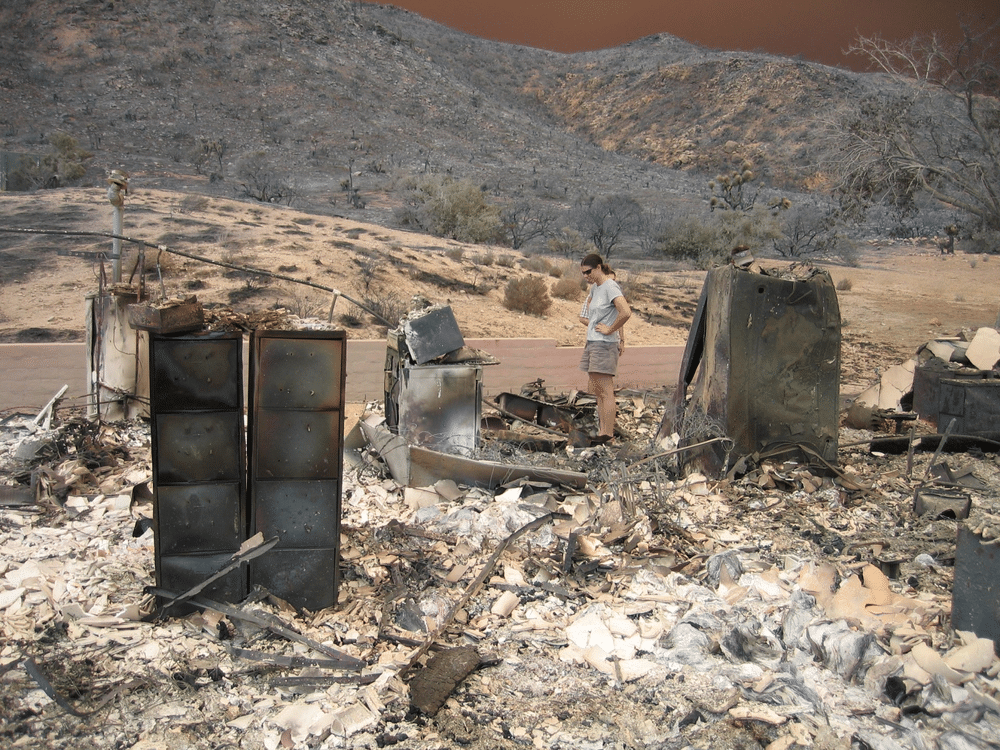
The remains of the outdoor program’s office after the 2006 Sawtooth Complex Fire.
The fire burned 87,000 acres, destroying a hundred buildings and killing one person.
Determining exact causes of a single wildfire is not always possible.
But we know that the global climate crisis is making regions of the world hotter and drier. And we know that as the climate changes, we therefore can expect more frequent and intense wildfires.
And we can expect more outdoor programs to experience the devastating effects of climate change.
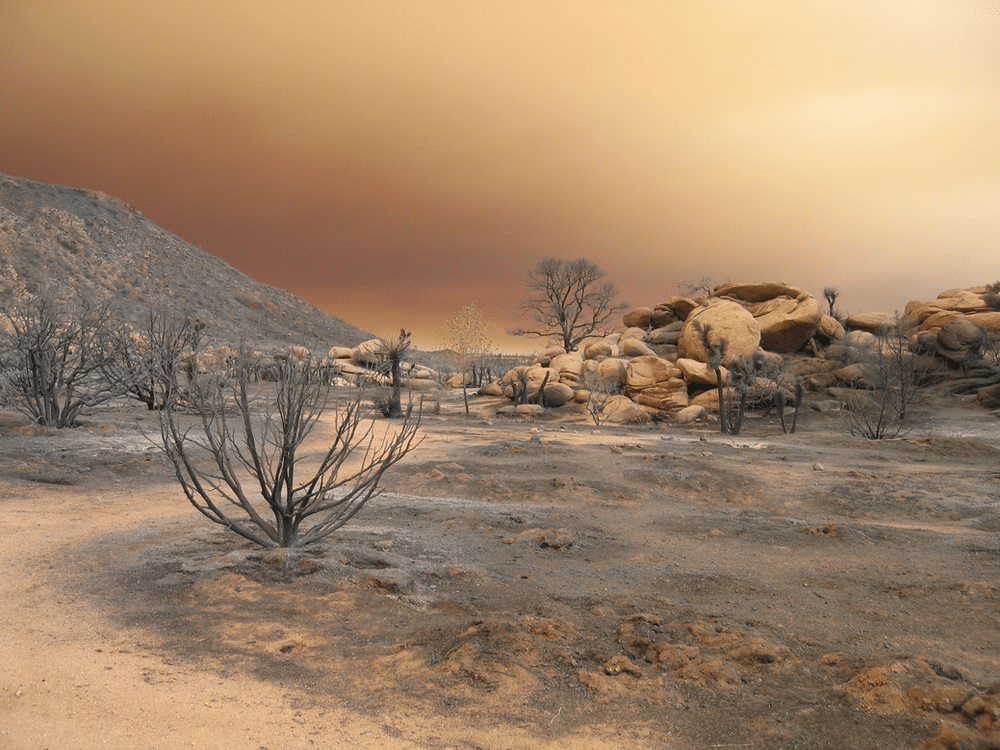
The education center’s outdoor classroom, after the fire.
How Does Climate Change Increase Risks to Outdoor and Experiential Programs?
The global climate crisis poses risks both directly and indirectly to outdoor, experiential, wilderness, travel, and adventure programs.
Direct risks include being caught in a wildfire or flood, or getting sick from a disease linked to climate change.
Indirect risks, such as the cost of rebuilding after a fire, or increases in insurance premiums due to climate risk, pose a threat to the business sustainability of outdoor programs.
The risk of an outdoor program participant falling ill from heat stroke during a record-setting hot day can be relatively easy to see.
The risk to ongoing operations of an outdoor program, brought on by repeated floods, recovery from which slowly depletes an organization’s financial reserves, can be more subtle.
Let’s look examples of how climate change increases both direct and indirect risks to outdoor programs. Some, like flash floods, are dramatic. Others, like unreliable water levels for boat trips, are less obvious. We’ll address the following:
- Wildfire
- Heat waves
- Floods
- Mudslides
- Algal blooms
- Ticks
- Water unreliability
- Rising oceans
- Disease
We’ll then look towards the future, consider issues of equity, and place climate-related outdoor safety in the context of outdoor program risk management.
Wildfire
Interruption & inconvenience
Wildfires don’t have to burn buildings to be destructive. They interrupt programming and add expense even when they just come near an outdoor program center, by causing disruptive evacuations and closures.
Rainbow Trail Lutheran Camp has evacuated its campers multiple times due to recent nearby fires, one of which closed the camp for five weeks.
Hazardous Smoke
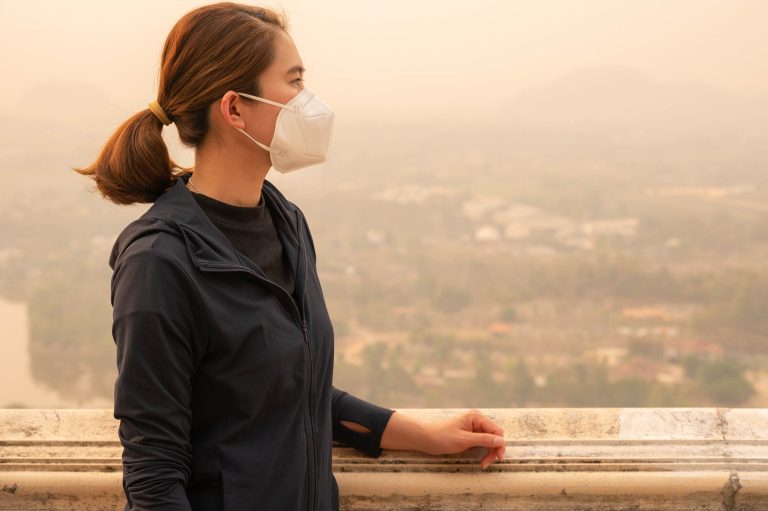
And it’s not just flames that cause problems: wildfire smoke alone can be damaging, too.
Increasing wildfires bring increasing smoke, which can lead to respiratory illness, and increase susceptibility to COVID-19. Smoke can also aggravate heart conditions and cause mental health concerns. Children are among those at higher risk.
Poor air quality from wildfire smoke can lead to limiting or cancelling outdoor activities.
On July 18, for instance, the Edmonton YMCA cancelled all outdoor program for its campers, due to hazardous levels of wildfire smoke. The City of Edmonton also closed a number of parks and other outdoor facilities.
Public health agencies are now issuing guidance about when to cancel outdoor activities due to hazardous levels of wildfire smoke.
Research shows wildfire smoke negatively influences the aesthetics of outdoor experiences, and leads to a statistically significant decrease in campground occupancy.
Outdoor-oriented business in wildfire-prone areas area bracing for serious financial losses from wildfire smoke.
Incineration
And outdoor program facilities burning to the ground is an increasing risk, too.
In the US state of California alone in the last several years, wildfires have taken a devastating toll on outdoor education programs, incinerating numerous camp and outdoor program facilities.
A partial list: Camp Newman burned in 2017; NatureBridge’s Santa Monica Mountains outdoor education campus closed indefinitely after a 2018 wildfire, and Camp Hess Kramer, Camp Hilltop, and Camp JCA Shalom burned down that year as well. In 2020, Camp Krem, the Sierra Streams Institute headquarters, Camp Skylark Ranch, and Camp Okizu were all destroyed by wildfire.
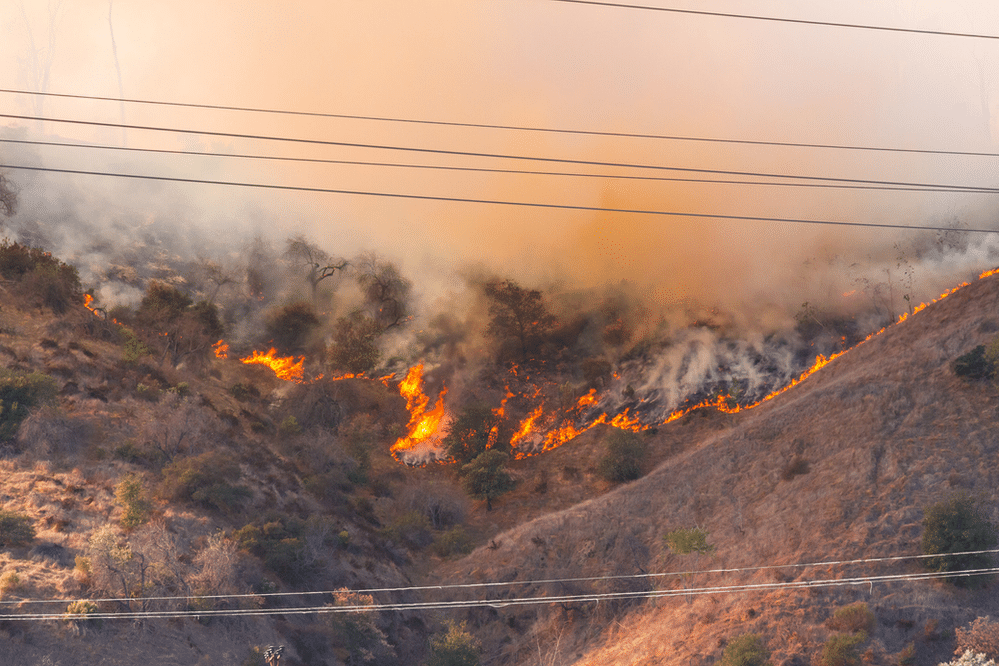
The 2008 Woolsey Fire burned the Santa Monica Mountains National Recreation Area, and halted outdoor programs there.
Heat Waves
Climate change is making the world hotter. Deadly heat waves are increasing in frequency and intensity. This brings increased risk of heat illness, requiring outdoor programs to adopt new safety procedures. And it can call for expensive changes to facilities as well.
A hiker on a Scout trip died of heat stroke on July 3 on a hiking trail in a large Hong Kong park amid 32 degree C (90 F) heat and high humidity; a Scout leader in the party also had heat stroke but survived. This follows a death in May from a trekker hiking up a mountain in Hong Kong in 36 degree C (97 F) heat, the hottest May day in Hong Kong in decades.
Following a fatality by heat stroke on an outdoor program in Hong Kong, an outdoor adventure nonprofit based in that city created new high-heat protocols. Hikers were encouraged to bring parasols to provide shade while trekking in the heat, and groups were restricted from traveling during mid-day heat.
But it’s not just warmer regions of the world that face dangerous heat: in British Columbia Canada, hundreds died in a June 2021 heat wave. Some died outdoors, unable to adapt to the sudden furnace-like air.
Summer camps have adapted to increased heat by observing for signs of heat-related illness, ensuring good hydration, and emphasizing activities involving water.
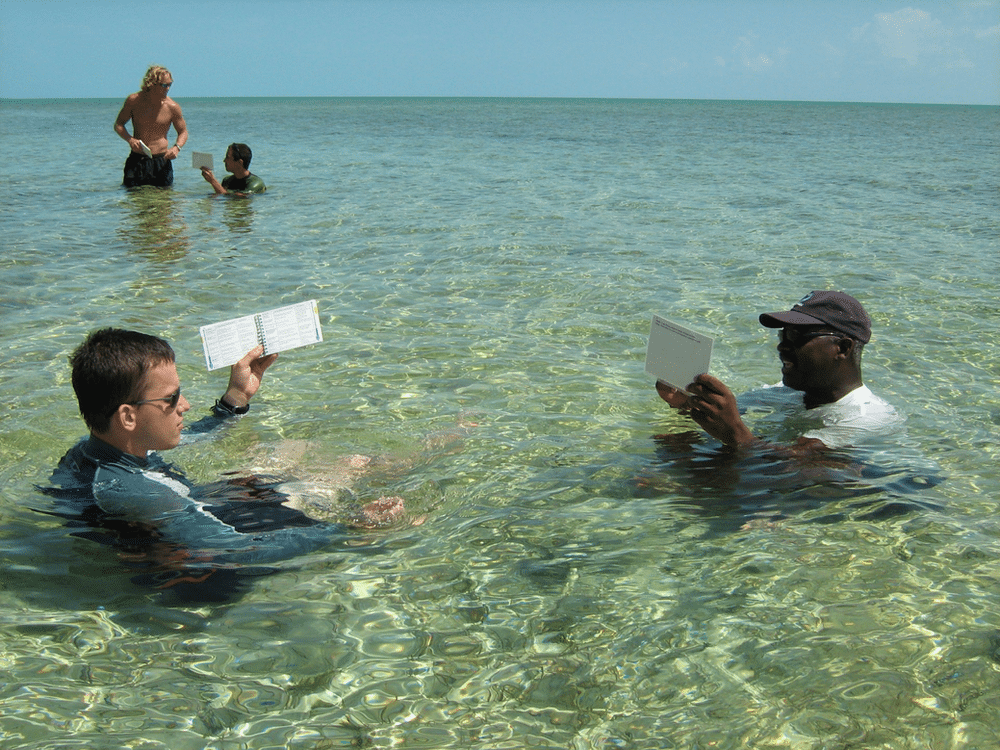
Classroom in the water: participants in a summertime outdoor education training course adapt to the heat during class in the Bahamas
And residential outdoor programs have spent heavily to install air conditioning and insulation to make buildings useable in now-hotter summers, increasing functionality but at a significant financial cost.
Floods
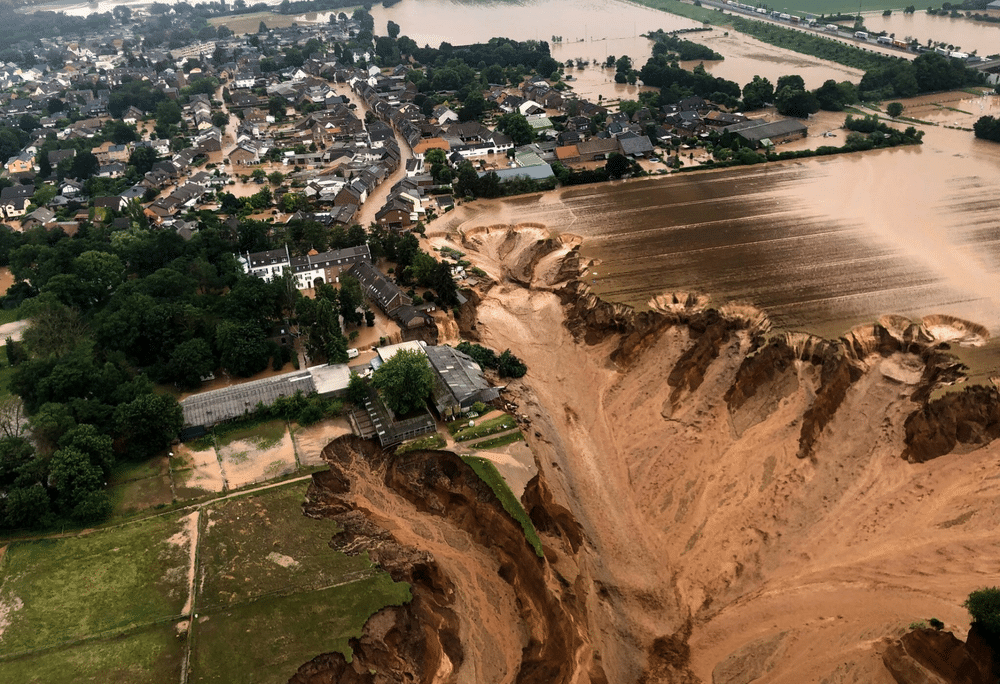
Flood damage in Erftstadt, Germany this month
Catastrophic floods in western Europe this month have killed at least 180 people, with thousands more missing, and thousands left homeless. Tens of thousands of homes have been flooded.
Climate change is at least partly to blame for what’s been called a thousand-year flood event. Ursula von der Leyen, the president of the European Commission, called the flooding “a clear indication of climate change.”
The floods in Europe were followed this week by deadly flooding in Henan province in central China, which killed dozens and trapped passengers in subway cars as floodwaters rose around them. The floods, attributed to climate change, were caused by “rainfall not seen in 1,000 years.”
While these floods made headlines for inundating homes and cities, outdoor programs are vulnerable to increasing flood risks too.
It’s not always possible to definitively tie a single weather event to climate change. But the science is clear that severe weather events are more likely to occur as a result of global climate change we’re seeing now.
Donald Wuebbles, professor in the Department of Atmospheric Sciences at the University of Illinois, notes the influence of climate change: “When we do get rainfall it’s more likely to be a bigger rainfall.”
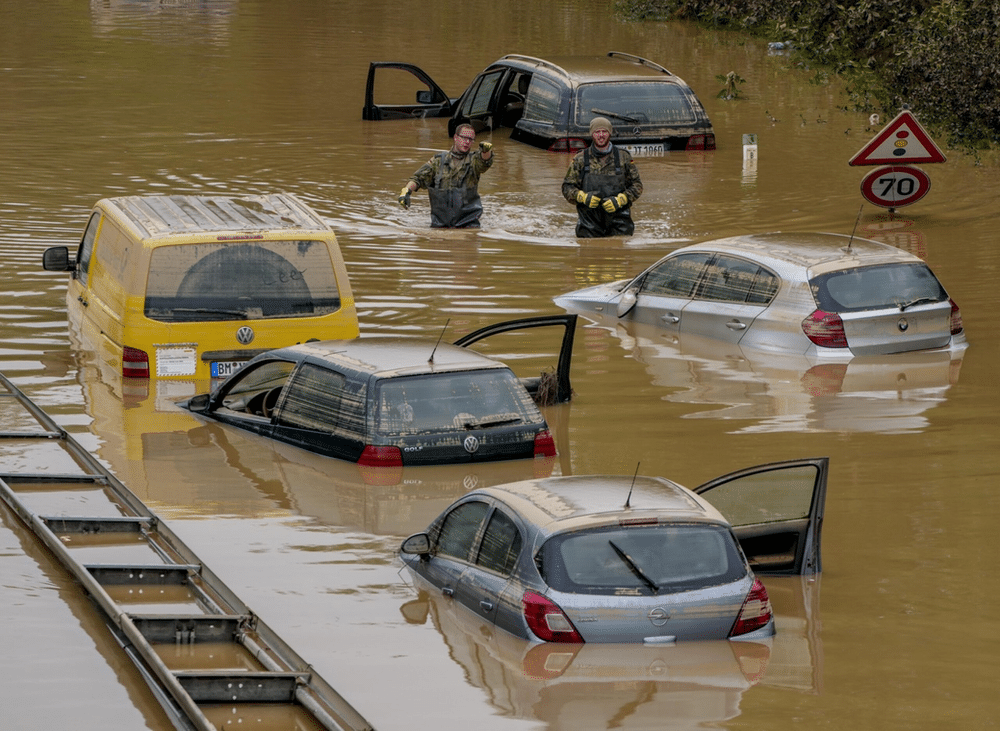
July floods in Europe damaged urban areas, but outdoor programs are at risk too.
Heavier rainfall can increase flash flood risks with outdoor activities. One person died and five were injured on July 14 when a flash flood on the Colorado River in Grand Canyon National Park in the southwestern USA washed away a campsite where about 30 people on a rafting trip were camped.
Ten teenagers recently drowned from a flash flood in a canyon during a three-day trek in Israel, and four months later, 11 hikers died in another sudden flood in a national park in Italy. In New Zealand, six students and their teacher drowned during an outdoor education program in a canyon flood.
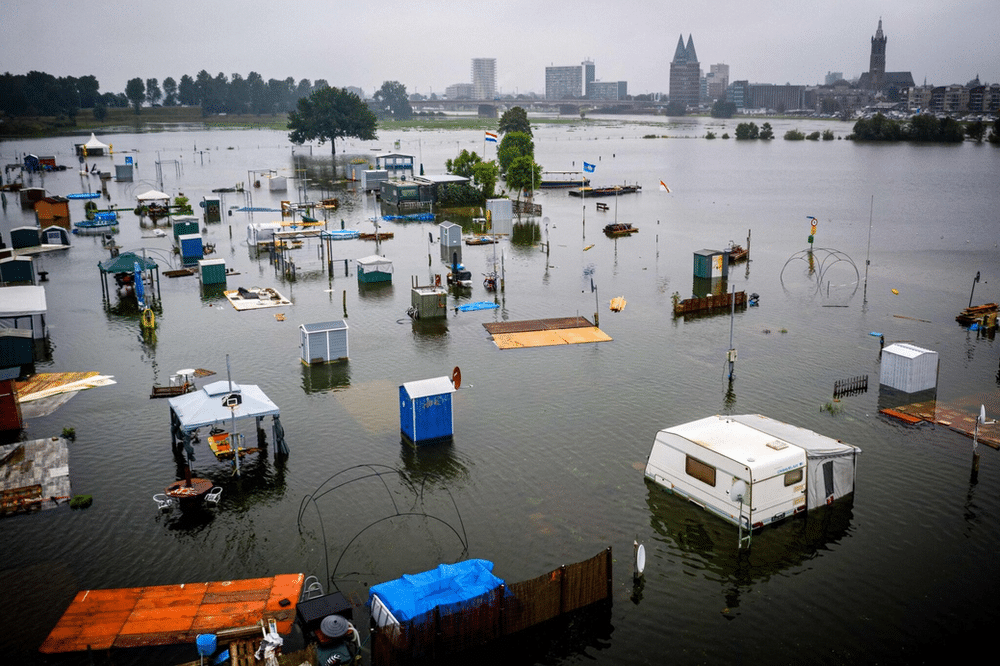
A submerged campground in Roermond, Netherlands makes outdoor activities more difficult.
Mud Slides
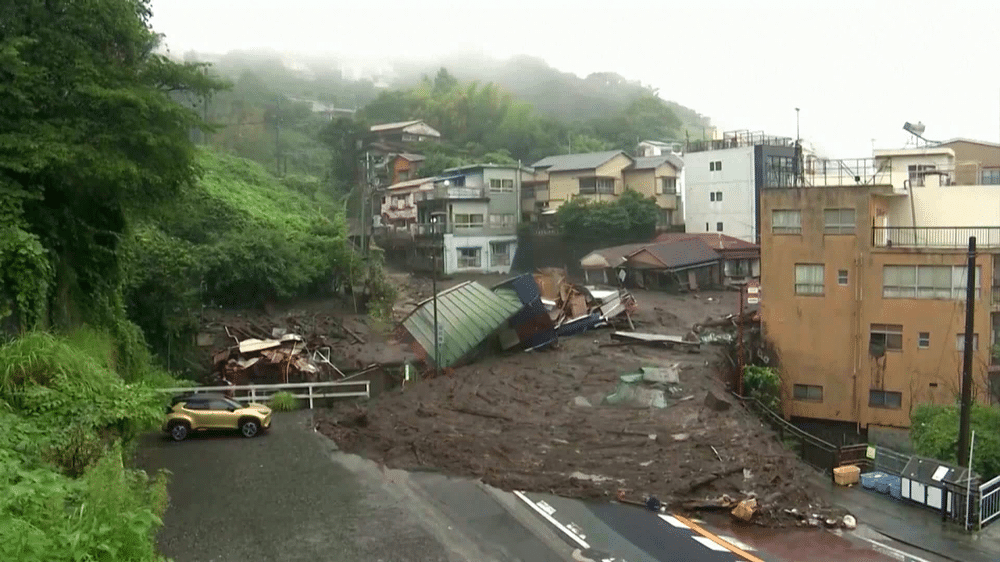
The July 3, 2021 mudslide in Atami, Japan
On July 3, a giant mudslide swept away more than 130 homes in Atami, Shizuoka prefecture, killing at least 2 people, with 20 missing. Thousands of households lost power.
The incident, which came after record-setting torrential rain in the area, is only one of several recent deadly mudslides in Japan.
The number of landslides in Japan have almost doubled in the last 10 years, averaging up to 1,500 annually. The risk of devastating mudslides is increasing, as rainfall rises due to climate change.
Mudslides can close rivers and hiking trails for use, and have inundated outdoor recreation facilities. And as mountain weather becomes more extreme and glaciers retreat, the American Alpine Club has observed increased danger from mudslides due to a changing climate.
Harmful algal blooms
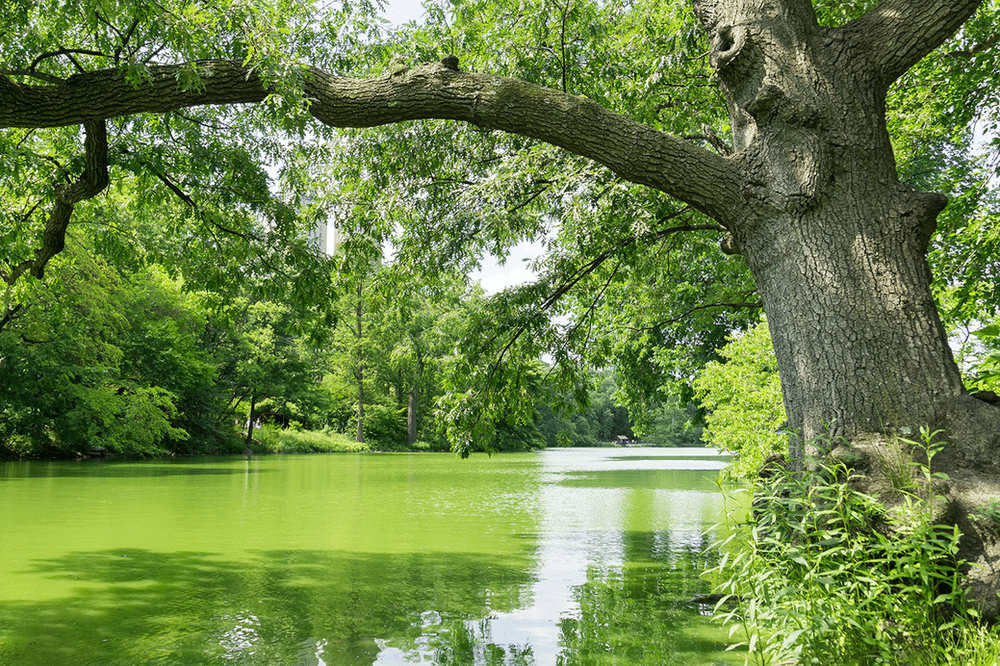
Would you swim in this? Swimming in or breathing water vapor from harmful algal blooms can be dangerous.
Harmful algal blooms hazardous to swimmers and others in or near the water appear to be increasing in frequency and intensity, driven by climate change. Drought can lower lake levels, concentrating agricultural runoff; torrential rainfall can trigger a sudden increase in agricultural nutrients. Both risk factors are brought on by a changing climate.
When the water warms in the summer sun, cyanobacteria absorb the sun’s energy and feed on nitrogen and phosphorus in the water. The bacteria excrete cyanotoxins, which may exacerbate asthma</u>; can damage the nervous system, liver and kidney, and can be fatal. The most dangerous cyanotoxin, microcystin, is toxic enough to be considered a biological weapon by the U.S. Department of Defense.
As a result beaches and entire lakes must be closed. A recent persistent bloom in Florida USA had such significant effects on water-based businesses the governor declared a state of emergency.
(Harmful algal blooms may have other effects, such as contaminating drinking water, making fish and shellfish toxic to eat, and killing whales.)
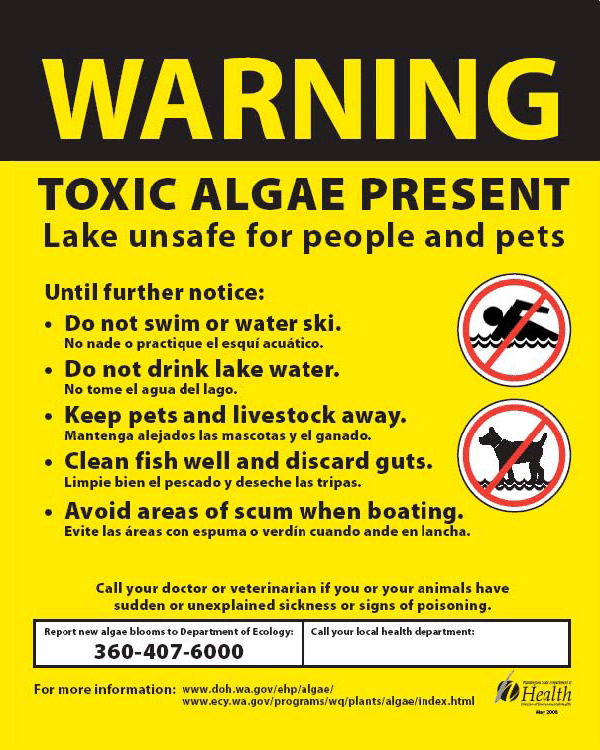
Ticks
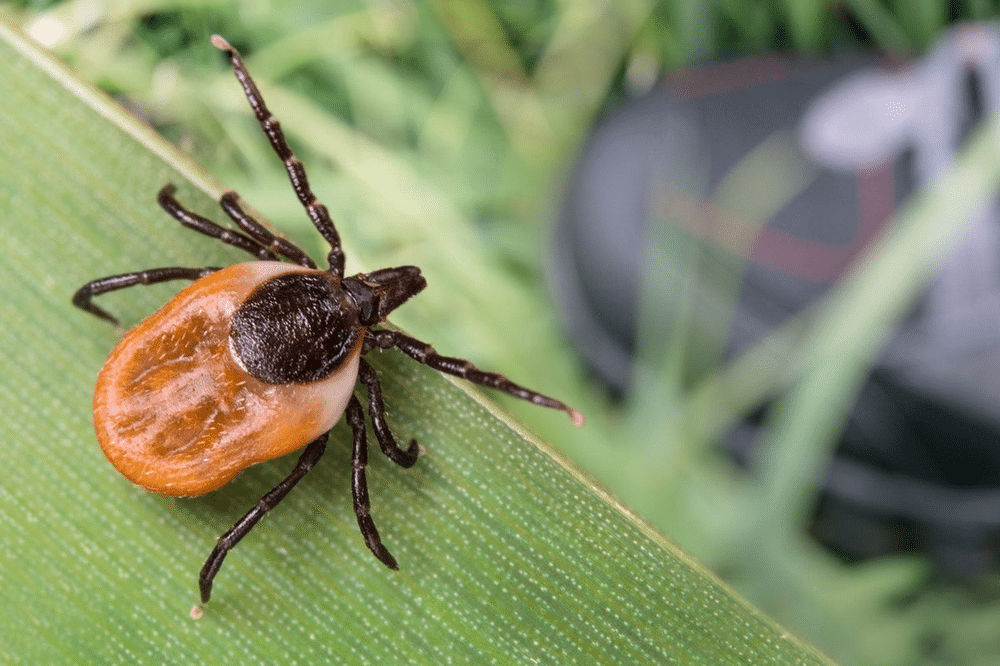
Ticks come in many shapes and sizes, and carry a toxin and many diseases.
Ticks can carry dozens of diseases, ranging from Lyme Disease to Kyasanur forest disease and Omsk Hemorrhagic Fever. They can also carry a neurotoxin causing paralysis and death. Tick populations are exploding in certain areas. Climate change disrupts migratory patterns of birds, which are a favored tick host, helping introduce ticks into new areas. Once there, milder winters brought about by climate change help ticks survive and lay eggs.
The US Centers for Disease Control and Prevention bluntly states: climate change increases the number and geographic range of disease-carrying insects and ticks.
Water unreliability
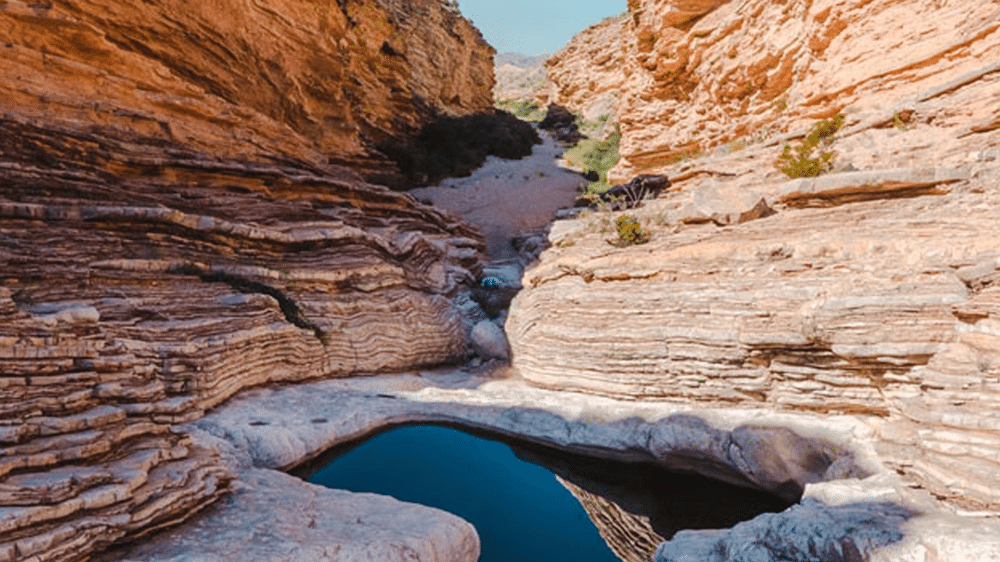
Ernst Tinaja in Big Bend National Park, Texas USA
While not as catastrophic as a life-threatening flood, climate change adds logistical complications to planning outdoor trips.
Rivers with predictable water levels enable managers to plan boating activities at safe water flows. And knowing which streams and tinajas (desert water pools) have water is important for ensuring hydration on overnight treks.
But this is changing. Julie Kroll of Camp Caroline Furnace Lutheran Camp and Retreat Center in Virginia USA noted that water sources “that used to be reliable in the ’90s are no longer reliable, or no longer exist.” She continued, noting that in addition, “river levels are no longer consistent.”
Rising Oceans
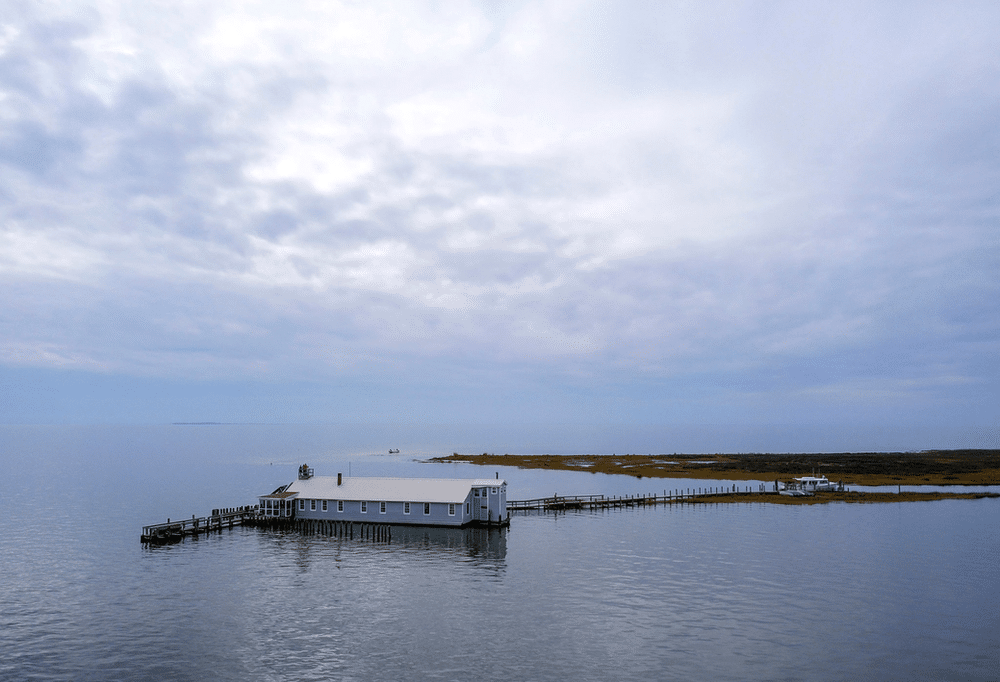
Fox Island Environmental Education Center, sinking under the waves of a rising sea
A changing climate is leading to rising seas, which can pose a safety hazard—and also literally wipe an outdoor education program off the map.
The Fox Island Environmental Education Center off the coast of Virginia USA closed in 2019, as the island on which it’s located is disappearing under the waves of a rising ocean.
More than 90 percent of Fox Island’s original 426 acres are now under water. Most of the loss occurred in the last 40 years.
Over those four decades, tens of thousands of children and school teachers had transformative outdoor learning experiences exploring the marshes, walking the beach, and canoeing around the island.
But the rising ocean overwhelmed nearby islands and salt marshes that sheltered the island from rough seas, and canoeing became too dangerous to continue.
The organization’s director of education operations said, “You have to check in and ask yourself, ‘Are we running a safe program?” He concluded: “The risk was too high to keep bringing kids out.”
The last group of children to stay at the outdoor center wrote poignant farewells in the visitor’s log book. They then boarded the boat back to the mainland, leaving Fox Island to disappear under the rising sea.
Health & Disease
The rising temperatures, more extreme weather, rising sea level and increasing CO2 levels of climate change have numerous impacts on human health.
- Changes in disease vector ecology lead to more malaria, encephalitis, Lyme disease, hantavirus, West Nile, and other diseases
- Increasing allergens increase respiratory allergies and asthma
- Water quality impacts increase occurrence of cryptosporidiosis, campylobacter, and, as previously discussed, harmful algal blooms, among other health impacts
- Water and food supply impacts increase diarrheal disease
- Environmental degradation leads to migration, civil conflict, and mental health impacts
- And extreme heat increases cardiovascular failure and, as mentioned above, heat-related illness and fatalities
Here we’ll focus on one facet that may particularly affect outdoor programs: mosquito-borne disease.
A study led by the London School of Hygiene and Tropical Medicine published in the Lancet shows that climate change is expected to threaten up to 4.7 billion more people with dengue and malaria, dangerous mosquito-borne diseases.
Dengue kills 20,000 people annually; malaria kills more than 400,000 people each year. Unabated climate change could more than double those numbers.
Outdoor programs in warmer areas of the world are vulnerable. Thailand, for example, has a tradition of outdoor education and recreation with both residents and tourists. But like other low- and moderate-income countries in dengue- and malaria-prone areas, its public health infrastructure is relatively unprepared for major outbreaks driven by climate change.
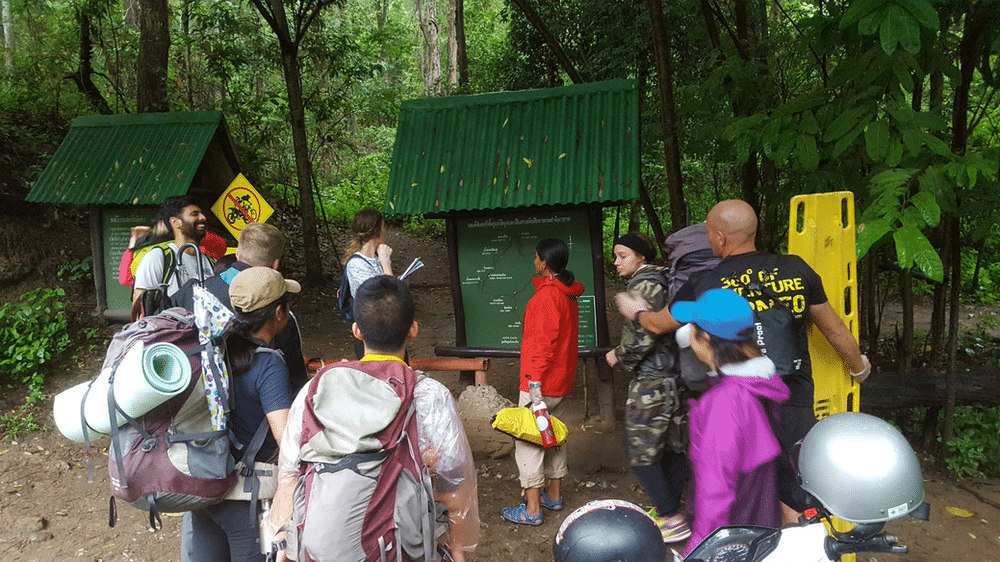
Trip leaders from outdoor programs across southeast Asia prepare for a field safety drill in Chiang Mai, Thailand
But a warming planet will spread mosquitoes carrying dengue and malaria to parts of the world currently too cool for them. Unless climate change is controlled, the mosquito Aedes aegypti–which carries dengue, zika, chikungunya, and yellow fever–is projected to spread farther and farther into the USA.
Climate change is also broadening the range of the Anopheles mosquito, which spreads malaria. And it lengthens the mosquito reproduction and transmission season, further increasing risk.
West Nile virus appeared in North America for the first time in New York, in 1999, after a drought followed by heavy rains. Over 1,600 have died to date. Cases across the US, now reported in 48 states, have been increasing. and research suggests that climate change will increase West Nile cases even further.
Guidance is available from the American Camp Association and public health agencies on reducing risk of infection with West Nile (and other vector-borne diseases), but is not a guarantee of protection.
The National Institutes of Health in the USA notes, “Climate changes and global warming will have catastrophic effects on human, animal and environmental ecosystems. Pathogens, especially tropical disease agents, are expected to emerge and re-emerge in several countries including Europe and North America.”
Disease Pandemics
A changing climate leads animals to seek new homes, bringing viruses and humans in closer contact.
Climate change also drives a “catastrophic loss of biodiversity” that destroys ecological controls preventing disease spread.
And climate change can resuscitate long-frozen viruses, as recently occurred with anthrax in Siberian permafrost, an incident which led to the death of one person and thousands of reindeer.
In these and other ways, climate change leads to an increase in pandemics.
While climate change is not held directly responsible for COVID-19, climate change makes future pandemics more likely to occur.
COVID-19 has killed over 4 million people, and taken a terrible social, emotional, health, and economic toll. Those of us who have survived with health and professional options intact are indeed very fortunate.
The impact of the COVID-19 pandemic on outdoor programs, however, has been enormous. Many have shut down; others are barely hanging on. Some radically transformed by offering online programming or other creative alternatives, although sometimes accompanied by the loss of jobs and great financial stress.
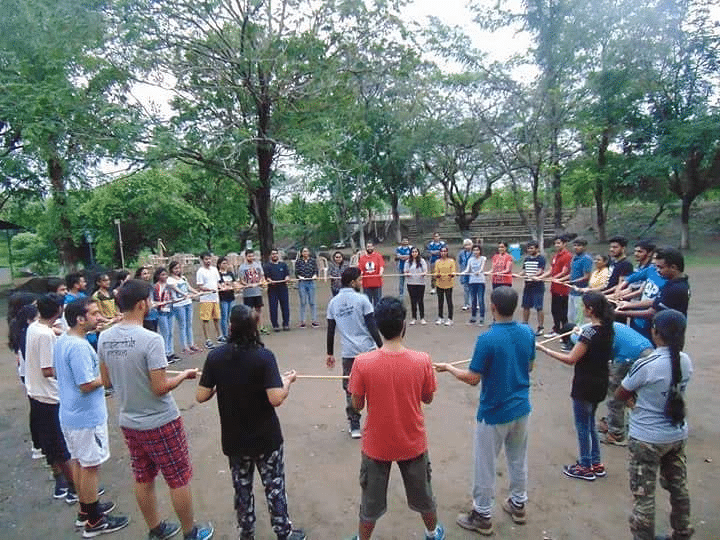
Outward Bound Bharat in action, pre-COVID-19. Photo credit: OB Bharat
The outdoor program Outward Bound Bharat, based in India, laid off employees and ceased operating programs in March 2020. Sudhir Moharir, OB Bharat’s Executive Director, projects the school won’t be able to begin programming again until 2022.
A two-year pause in programming deprives people of the opportunity to experience the life-enhancing benefits of high-quality experiential education and outdoor adventurous activities. But it is also an enormous operational and financial blow to any organization.
It’s reasonable that any outdoor program would wish to see the factors that could lead to another prolonged and harmful pandemic be reduced.
The Future
Short Term Outlook: Getting Worse
Recent floods, wildfires, and other extreme weather events can appear apocalyptic. Global risk management professionals ask, is this expected to continue? Will it likely get even worse?
The answer, in a word: yes.
The Intergovernmental Panel on Climate Change reports that the frequency of severe weather events such as flooding and drought will increase as temperatures continue to rise.
Anthropogenic global warming should come to a halt, however—eventually. The EU has agreed to cut emissions of greenhouse gases by 55 percent by 2030, compared to 1990 levels, and aims to be carbon-neutral by 2050. The EU recently proposed plans to significantly reduce fossil fuel use to help meet this goal, for example by eliminating gas-powered car sales in the EU within 14 years.
However, even if the EU does reach its goal by 2050, it may take many more years to remove the existing excess carbon from the atmosphere.
And the plans from other major greenhouse gas emitters, such as China and the USA, are much weaker than those of the EU.
An Unpredictable Future
Outdoor programs and others seek to understand what future climate and weather will look like. This will help in making effective plans to be resilient in the face of a changing climate.
But a new challenge has arisen: the scientific models that predict future severe weather are breaking down.
Although greenhouse gas emissions have been long predicted to lead to more floods, heat waves, droughts, and other weather extremes, the current extreme weather events have been more severe than models anticipated.
The floods this month in Germany and elsewhere in western Europe are a case in point. German meteorological officials have a well-developed severe weather risk assessment and warning system, including real-time river level sensors. And the system functioned as it was designed to do.
The problem was that so much rain fell, so fast, that even small streams began to flood, which was unexpected and not accounted for in the warning system.
Administrators responsible for wilderness risk management, international travel considerations, or any other aspect of outdoor safety should now take into account the increased probability of unanticipated climate-related effects.
Long Term: A Case for Optimism
Climate change is affecting not just outdoor programs, but everybody, everywhere. And awareness is growing about the global climate emergency.
Governments and NGOs around the world are mobilizing to reduce and reverse the effects of climate change. Scientists are improving climate models and developing technologies to help de-carbonize the global economy. Countless individuals are making contributions in their everyday lives.
The world has faced great crises in the past, and come through them, eventually. And there’s every expectation that we will find ways to resolve the global climate emergency, and in so doing, reduce climate related risks for not only outdoor programs, but all of humanity.
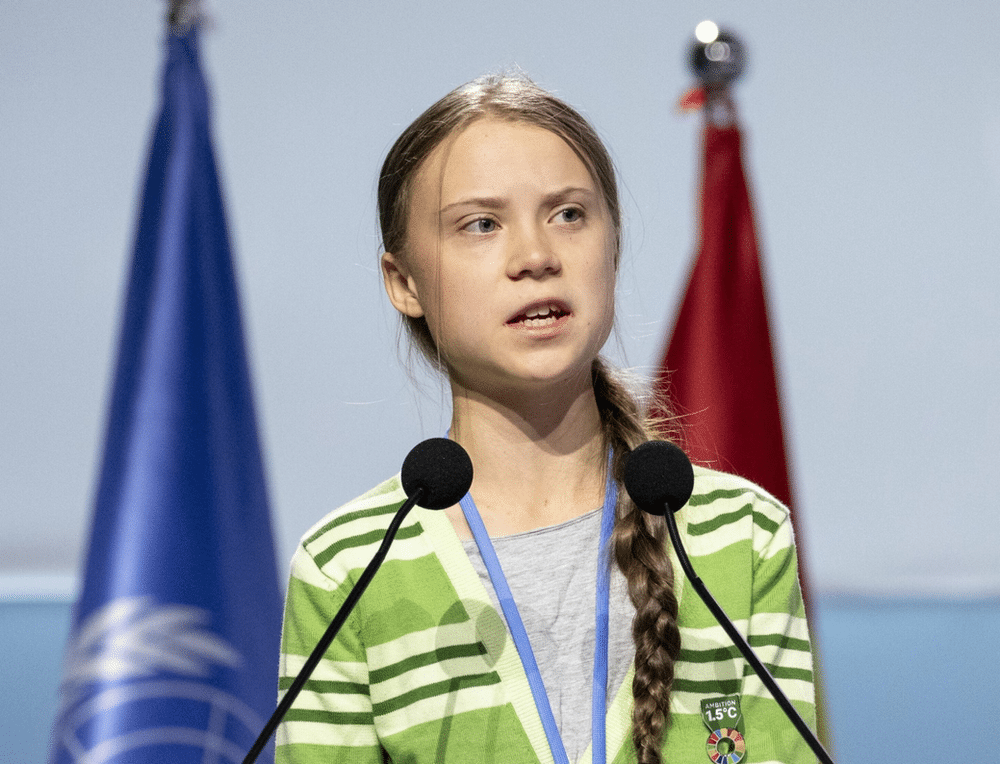
Climate activist Greta Thunberg
An Issue of Equity
There’s one issue regarding climate change that should not be ignored: the impacts of the global climate crisis disproportionately affect those with the least privilege and the fewest resources to be able to deal with a changing climate.
Some outdoor programs, in countries where vaccination rates are high (or where public health systems are very high-functioning), have been able to re-open and resume near-normal operations. New Zealand and Iceland are examples. But in India, which could not out-compete rich counties in the race to buy up vaccine stocks, Outward Bound Bharat faces a long wait until re-opening.
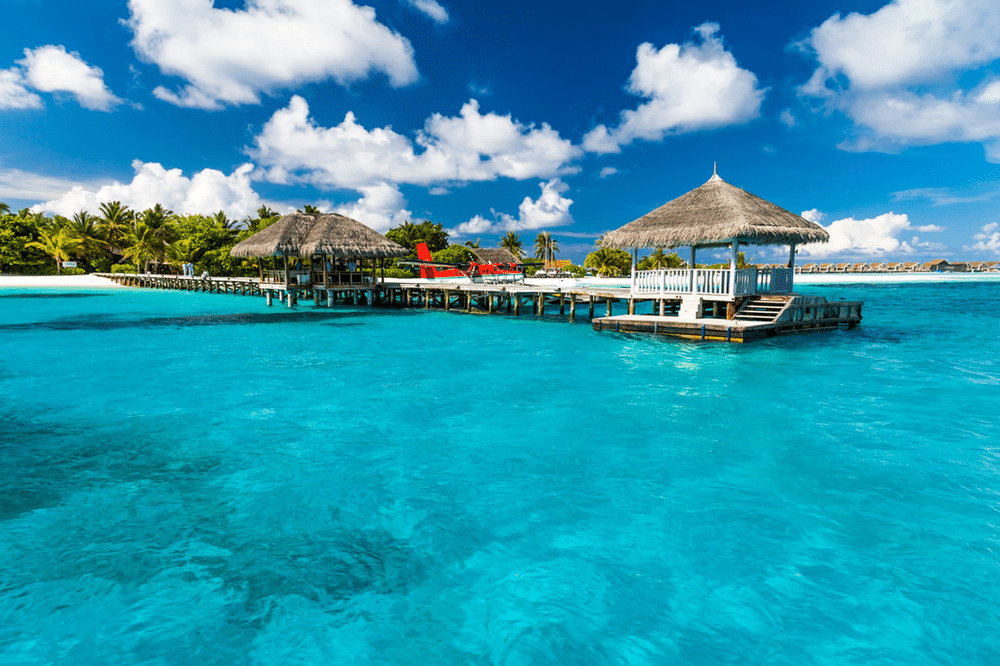
The Maldives. A paradise for outdoor adventures, but at risk from climate change
The Maldives, an island nation in the Indian Ocean, is an attractive destination for school groups to experience field science and environmental education programs hosted by organizations like the Maldives Whale Shark Research Programme.
The archipelago of the Maldives is known for diving, surfing and other outdoor adventures. But more than 80% of the Maldives’ land is less than one meter above mean sea level. The Intergovernmental Panel on Climate Changes anticipates sea level could rise up to one meter or more by 2100 if greenhouse gas emissions continue to increase strongly. Outdoor programs in Maldives, then, face the prospect of the entire country disappearing underwater by 2100.
(The IPCC’s report further projects that beyond 2100, sea level will continue to rise for centuries, and will remain elevated for thousands of years.)
The Maldives lacks the financial resources to build defenses against the rising sea. The country’s Environment Minister recently asked, “We have to beg some of these (big) emitters to provide money for us. Is that fair?”
The trend of lower-income countries disproportionately bearing the brunt of the effects of climate change continues around the world. The IPCC reports that fatality rates and economic losses (as a proportion of GDP) are higher in developing countries. From 1970 to 2008, the IPCC notes, over 95% of deaths from natural disasters occurred in developing countries.
Climate Change and Outdoor Safety: The Big Picture
It’s abundantly clear than climate change poses substantial risks to outdoor programs—and the rest of the world. Let’s put climate-based risk into context by looking at a model that can provide a comprehensive illustration of risks that outdoor programs face.

Underlying & Direct Risk Domains: the “risk reservoirs” from which come risks that lead to an incident.
Why do accidents occur? A number of models attempt to respond to the question of what causes incidents to happen.
The Risk Domains model, pictured above, is one such model. Here, we see that there are eight direct risk domains (in yellow), which can lead to an incident. For example, a poor safety culture, inadequately trained staff, or malfunctioning equipment can bring about a mishap.
Policies, procedures, values and systems can be instituted to manage risks that have been identified in each risk domain as being present for any given outdoor program. Those policies, procedures, values and systems can help reduce risks to a socially acceptable level.
The model also recognizes four “indirect risk domains,” in fuchsia. The absence of effective government regulations, an outdoor industry that fails to establish appropriate safety standards, and large corporations with an anti-regulatory agenda which degrade the ability of government to provide good safety governance are examples of risks in these indirect risk domains.
This model has been used to both prevent incidents from occurring in outdoor programs, and to analyze the cause of critical incidents once they have occurred. Other models, such as AcciMap, HFACS, STAMP and their variants, also offer illustrations of the factors from which incidents arise.
The Risk Domains model also incorporates 11 risk management “instruments,” or tools, which can broadly mitigate risks across multiple risk domains.
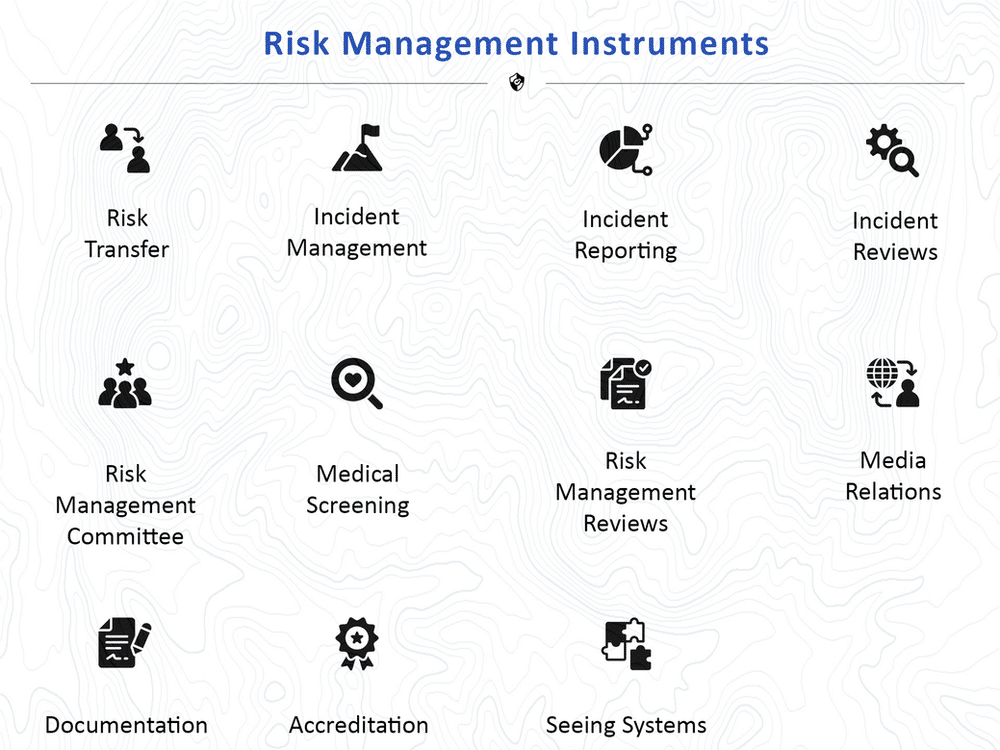
Risk Management Instruments, tools used to reduce risks across many risk domains at once.
For example, liability insurance, an aspect of the ‘risk transfer’ instrument, can reduce the severity of losses to an organization following a major incident. Risk management reviews, which are comprehensive and proactive safety audits, can help prevent mishaps from occurring in the first place.
Notably, one risk management instrument, ‘seeing systems,’ encourages model-users to apply complex socio-technical systems theory to the management of risk, bringing the most advanced contemporary theories of incident causation to the world of outdoor safety.
This outdoor safety management model is further described in the textbook Risk Management for Outdoor Programs: A Guide to Safety in Outdoor Education, Recreation and Adventure.
Detailed training on how to implement the model for outdoor, experiential, adventure, wilderness and travel program is available in the 40-hour online training, Risk Management for Outdoor Programs, provided by Viristar.
Another good opportunity to see how a comprehensive systems-based risk management model is integrated into outdoor programs can be found in the UPLOADS Project in Australia, which encourages outdoor programs there to analyze incidents using a comprehensive outdoor safety model.
Climate Change, in Context
Where does climate change fit into the risk domains model?
Business Administration
Climate change fits into the Business Administration risk domain. This is because climate change can pose an existential risk to ongoing continuity of outdoor programs, as in the examples above where outdoor programs shut down completely due to wildfire or rising seas.
Climate change can also degrade an organization’s resiliency to business impacts (such as from a pandemic or bad publicity) by increasing operating costs. Costs may rise due to a number of factors, from expenses of installing air-conditioning and insulation, costs of finding new course areas less impacted by climate change, costs of training staff in wildfire risk management, and so on.
Part of good risk management, from a business standpoint, is evaluating strategic risks that may, over time, have negative impacts on a company. This is a different sort of risk management than that of day-to-day safety management procedures for preventing sunburns and sprained ankles. But it’s important, nonetheless.
Other strategic risks besides climate change that outdoor programs may face include demographic changes (such as a tendency towards urbanization and electronic entertainment, reducing interest in outdoor experiences) and geopolitical instability, in which international conflict can make outdoor programming more difficult.
The term “enterprise risk management” is also used to describe the process of understanding and addressing these broad and sometimes abstract and slow-moving risks that nevertheless can have enormous impacts on an organization’s capacity to continue its operations.
Activities & Programs Areas
The risk domain of Activities & Program areas is another region where climate-related risks reside. Glacial floods caused by global warming add a new hazard to alpine mountaineering, for example.
And summer-time activities that were suitable 30 years ago may only be safe enough to offer in the fall or spring, due to rising temperatures.
All Other Risk Domains
We mentioned systems thinking, and complex socio-technical systems theory, above, and its role in outdoor risk management. Systems thinking should pervade all aspects of outdoor risk management, and climate change is no exception.
(Systems thinking may also come with the labels ‘Safety-II’ in the Safety-I/Safety-II paradigm, ‘safety differently,’ and ‘guided adaptability,’ in the risk management lexicon.)
Climate change can influence risks in any risk domain. Examples of how good outdoor safety management can address climate change in various risk domains include:
- Safety culture: increasing awareness of heat-related illness, rather than encouraging people to “push through the heat” during heat waves
- Staff: changing staff training to help field staff address new hazards such as floods, fires, harmful algal blooms and heat waves, and, in addition, adding climate change to environmental education curricula
- Equipment: adapting safety and rescue supplies to better accommodate incidents involving heat-related injury, flooding and the like
- Participants: changing participant equipment lists and training to adapt to extremes of weather such as heavy rainfall and extreme heat
- Subcontractors: ensuring program providers are adjusting procedures, training, equipment, etc. to respond to climate-borne hazards
A high-quality risk management plan will incorporate climate influences into all aspects of an organization’s safety systems.
Hope for the Future
Climate change poses clear and significant risks to outdoor programs—and all aspects of society. These risks are likely to increase in upcoming years. Yet, there is good cause for optimism.
Organizations like Outdoor Alliance, through its Adventurers for Climate effort and in other ways, work to address the impact of climate change on the outdoors and outdoor programs.
The North American Association for Environmental Education provides outstanding guidance for helping educators foster responsible environmental citizens through high-quality environmental education programming.
And outdoor education, outdoor recreation, adventure tourism, experiential education, wilderness travel and related programs around the world are making a difference. These organization can help people develop a close relationship with the natural world and build the skills to foster environmentally sustainable communities, economies and societies.
Rising from the Ashes
The outdoor program whose 335-acre high desert California campus was incinerated by a wildfire suffered a devastating blow.
But the program’s staff, several of whom were suddenly homeless, and all of whom were bereft of an office, met at a nearby coffee shop, in town. They opened up their personal laptops, picked up their cellphones, and made a plan to carry on.
The nonprofit cancelled no programs. Donations of outdoor gear and supplies poured in from around the country. A capital campaign raised funds to purchase a new headquarters. With great effort from a hard-working staff team, the organization rose from the ashes and carried on.
Backpacking, rock climbing, sea kayaking, canoe expeditions and other outdoor programs continued. And when the COVID-19 pandemic struck, the organization pivoted again, with plans for socially distanced day programs to replace its wilderness expeditions.
The resilience and adaptability the organization showed, in the face challenges from climate change and beyond, is a reminder that we are resourceful, creative, and adaptive.
It’s a reminder that we have the capacities to successfully address the issue of a changing climate.
We will persevere.
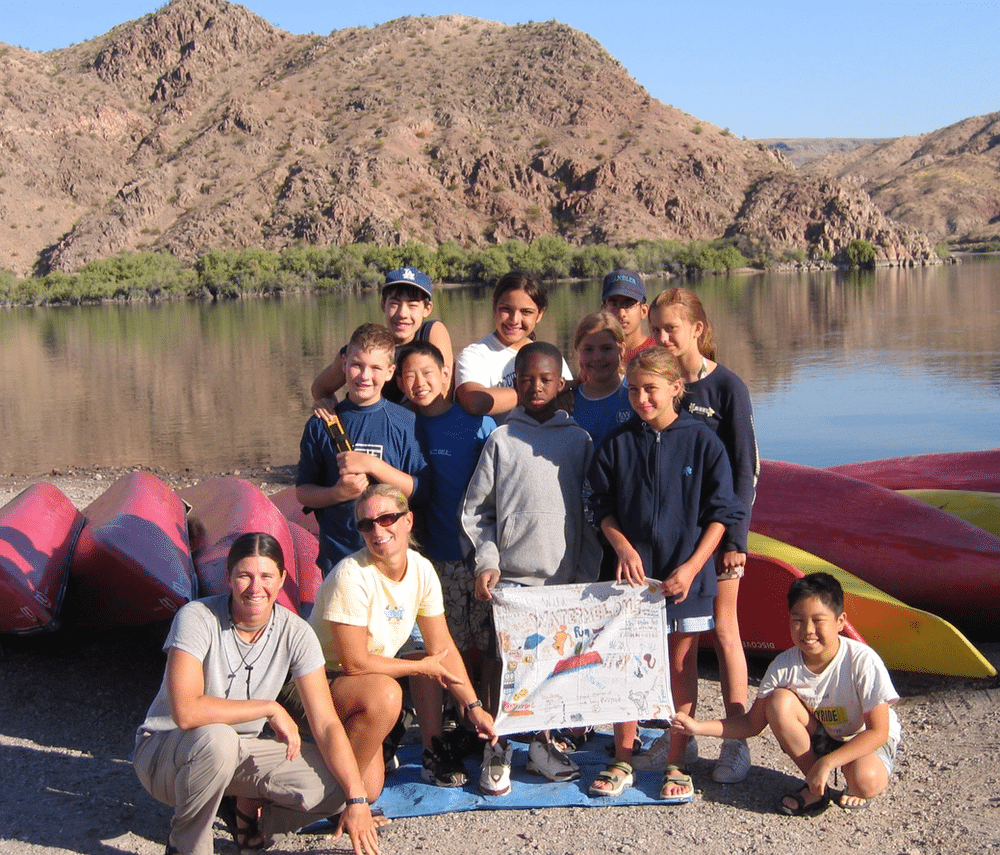
Participants at the end of a canoeing expedition on the Colorado river led by the outdoor program.
